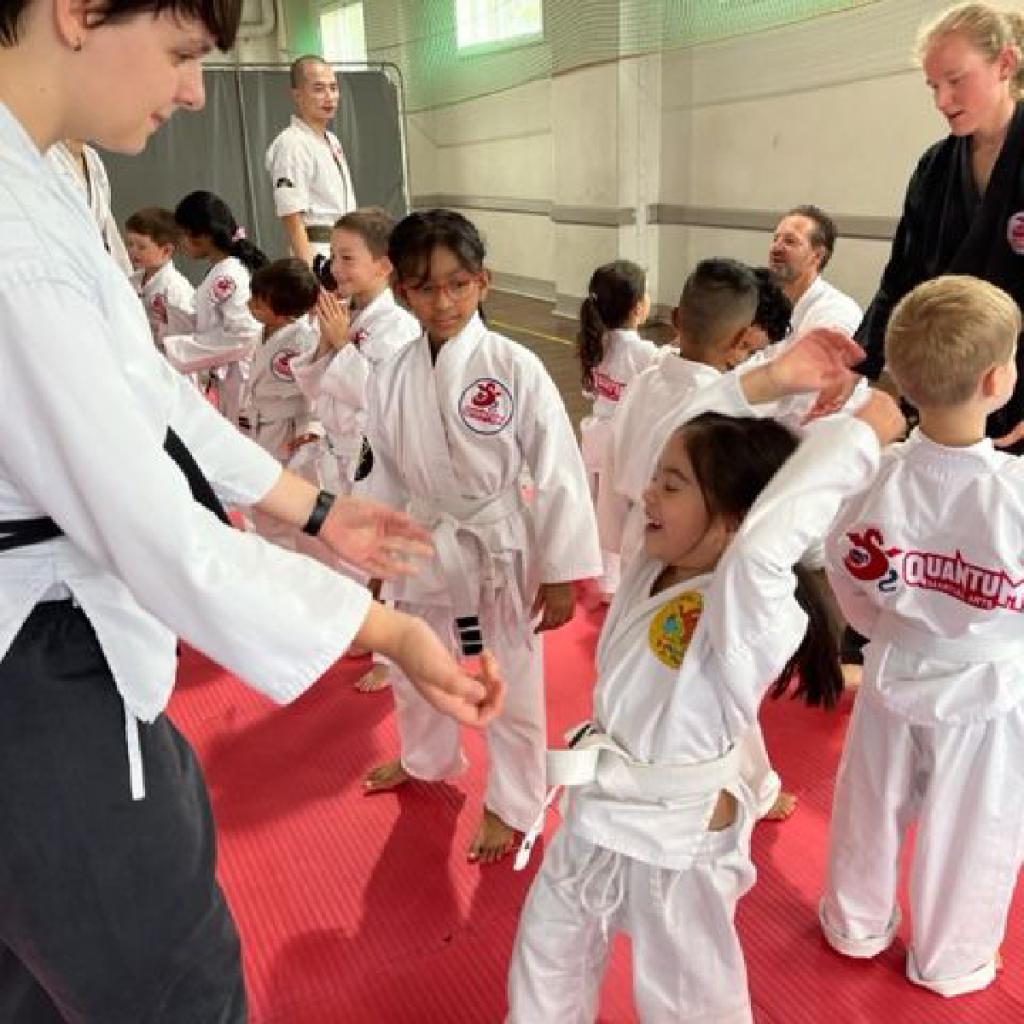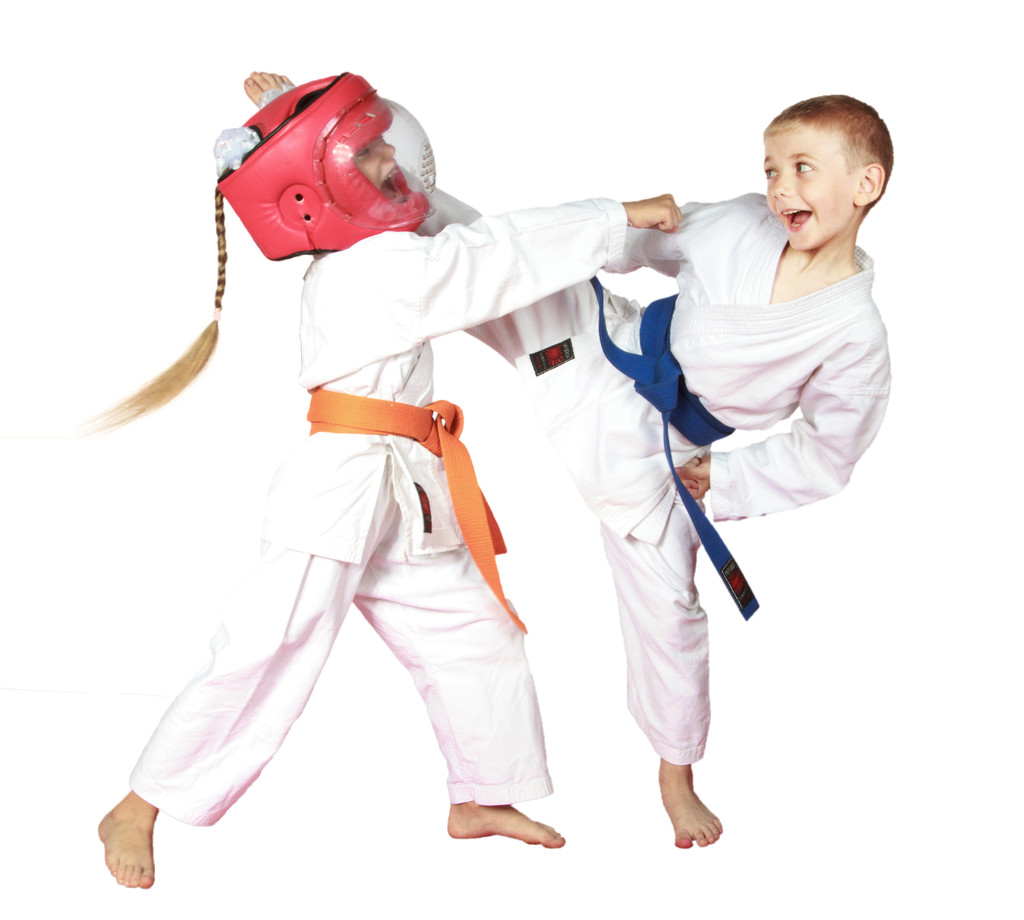Discover how to effectively teach self-defense techniques to 8-9 year old children with this comprehensive step-by-step guide.
Teaching Self-Defense to 8-9 Year Old Children: A Step-by-Step Guide
Teaching self-defense to 8-9 year old children can be an exciting and fulfilling experience. Not only does it empower them with important skills to protect themselves, but it also boosts their confidence and physical fitness. In this step-by-step guide, we will explore the various aspects of teaching self-defense to this age group, from understanding its importance to incorporating it into their daily routine, while ensuring their safety throughout the training process.

Understanding the Importance of Self-Defense for Children
Self-defense plays a crucial role in child safety. It equips children with the knowledge and skills to recognize potential dangers and make sound decisions when faced with threatening situations. By teaching them how to defend themselves, we empower them to take control of their personal safety and build resilience from a young age.
Child safety is paramount, and self-defense plays a vital part in it. Teaching children self-defense instills a sense of personal responsibility and assertiveness, helping them navigate through potentially dangerous situations. By arming them with techniques to protect themselves, we empower them to avoid becoming easy targets.
Moreover, self-defense training goes beyond just physical protection. It also focuses on mental preparedness and awareness. Children learn to assess their surroundings, identify potential risks, and develop strategies to stay safe. This heightened sense of awareness not only helps them in self-defense situations but also in everyday life, where they can make informed decisions to protect themselves.
Self-defense not only strengthens physical abilities but also builds confidence in children. By mastering self-defense techniques and realizing their own capabilities, children develop a sense of self-assurance that transcends into other areas of life. They gain the confidence to assert themselves, set boundaries, and stand up against bullying or harassment.
Additionally, self-defense training promotes physical fitness, coordination, and overall well-being. Through regular practice, children improve their strength, flexibility, and endurance. They develop better motor skills, hand-eye coordination, and balance, which can benefit them in various sports and physical activities.
Furthermore, self-defense training provides an avenue for children to develop discipline, focus, and perseverance. They learn to set goals, work towards them, and overcome challenges. This mindset of continuous improvement and determination can have a positive impact on their academic performance and personal growth.
It is important to note that self-defense training for children should be age-appropriate and taught by qualified instructors who prioritize safety and emphasize non-violent conflict resolution. The focus should be on teaching children how to protect themselves and escape dangerous situations rather than promoting aggression.
In conclusion, self-defense is not just about physical techniques; it is a comprehensive approach to child safety. By equipping children with self-defense skills, we empower them to become more confident, aware, and resilient individuals. It is an investment in their personal safety, well-being, and overall development.
Preparing for Self-Defense Training
Before diving into self-defense training, it is important to assess your child’s physical abilities and set realistic goals. This ensures that the training is tailored to their individual capabilities, making it an enjoyable and safe experience.
Assessing Your Child’s Physical Abilities
Every child is unique, and their physical abilities may vary. Assessing your child’s strength, coordination, and flexibility is an essential step in preparing them for self-defense training. By understanding their starting point, you can structure the training accordingly, ensuring that it is challenging yet within their capabilities.
When assessing your child’s strength, consider their upper body, lower body, and core strength. This will give you an idea of their overall physical power and determine the level of resistance they can handle during training. Additionally, evaluating their coordination will help you understand their ability to perform complex movements and techniques effectively.
Flexibility is another crucial aspect to assess. It determines the range of motion your child can achieve, which is essential for executing self-defense techniques accurately. By identifying any limitations in their flexibility, you can incorporate stretching exercises into their training routine to improve their overall range of motion.
Setting Realistic Goals for Self-Defense Training
Setting realistic goals for your child’s self-defense training is vital to their progress and overall motivation. It is essential to break down the skills into smaller achievable milestones, allowing them to progress gradually and build confidence along the way.
Consider the specific self-defense techniques you want your child to learn and develop. Whether it’s punches, kicks, or grappling techniques, breaking them down into smaller components will make the learning process more manageable. By focusing on one skill at a time, your child can master each technique before moving on to the next, ensuring a solid foundation.
Furthermore, celebrate your child’s accomplishments along the way. Recognizing their hard work and dedication will nurture their motivation and enthusiasm for further training. Whether it’s a small milestone or a significant achievement, acknowledging their progress will boost their self-confidence and encourage them to continue their self-defense journey.
Remember, self-defense training is not just about physical skills but also about developing mental resilience and awareness. Encourage your child to stay focused, disciplined, and aware of their surroundings. By instilling these qualities, they will be better prepared to handle challenging situations and protect themselves.
Basic Self-Defense Techniques for Children
Teaching children the basics of self-defense is an essential first step on their martial arts journey. By focusing on fundamental techniques, we lay a strong foundation for their future development.
Self-defense is not just about physical techniques, but also about developing mental and emotional resilience. It empowers children to protect themselves and boosts their confidence in various situations. Here, we will delve deeper into some key aspects of teaching self-defense to children.
Teaching the Right Stance and Movement
A proper stance and movement are fundamental in self-defense. Teach your child how to stand with their feet shoulder-width apart and their body slightly crouched. Emphasize the importance of balance, as it allows for swift and controlled movements when needed.
Additionally, explain to your child the significance of maintaining eye contact with potential threats. This not only shows assertiveness but also helps in assessing the situation and identifying possible escape routes.
Simple Strikes and Blocks for Kids
Introduce children to simple strikes and blocks that are suitable for their age and physical abilities. Teach them how to generate power from their core while maintaining control and precision. Sneak in some playful exercises to keep them engaged and make the learning process enjoyable.
It is important to emphasize the concept of self-defense as a last resort. Teach your child that physical techniques should only be used when there is no other option and their safety is at risk. Encourage them to prioritize de-escalation and verbal assertiveness as their primary tools for diffusing conflicts.
Furthermore, educate your child about the importance of situational awareness. Teach them to be mindful of their surroundings, identify potential danger signs, and trust their instincts. This awareness will enable them to make quick decisions and take appropriate action when faced with a threatening situation.
Remember, self-defense is not just about physical strength, but also about mental and emotional strength. Encourage your child to develop self-confidence, assertiveness, and resilience through regular practice and positive reinforcement. By instilling these qualities, you are equipping them with valuable life skills that go beyond self-defense.
Incorporating Self-Defense into Daily Routine
To reinforce self-defense skills, it is beneficial to incorporate them into your child’s daily routine. By making it a regular part of their lives, self-defense becomes second nature and ingrained as a habit.
One way to incorporate self-defense into your child’s daily routine is by discussing real-life scenarios and teaching them how to react in different situations. For example, you can have conversations about stranger danger and what to do if someone approaches them in a suspicious manner. By having these discussions regularly, your child will become more aware of their surroundings and develop a sense of confidence in their ability to handle potential threats.
Another way to integrate self-defense into your child’s daily routine is by teaching them basic self-defense techniques. This can include simple moves like palm strikes, elbow strikes, and knee strikes. By practicing these techniques regularly, your child will become more comfortable and proficient in executing them, increasing their chances of successfully defending themselves if the need arises.
Fun Self-Defense Drills for Home Practice
Design fun self-defense drills that your child can practice at home. Encourage them to perform movements, strikes, and blocks in a controlled and deliberate manner. Consider turning it into a game or competition to boost their enthusiasm and make it an enjoyable family activity.
One drill you can try is the “obstacle course” where you set up different objects around the house for your child to navigate while practicing their self-defense moves. This not only helps them improve their physical agility but also enhances their ability to react quickly in different environments.
Another fun drill is the “mirror exercise” where you and your child stand in front of a mirror and take turns mimicking each other’s self-defense moves. This not only allows your child to practice their techniques but also helps them develop better body awareness and coordination.
Encouraging Regular Physical Activity for Better Defense Skills
Regular physical activity is crucial for developing and maintaining defense skills. Encourage your child to engage in activities such as swimming, martial arts, or team sports, as they contribute to overall fitness, coordination, and endurance.
Swimming, for example, is an excellent activity for building strength and stamina. It also teaches your child how to stay calm and focused in water, which can translate to self-defense situations where remaining composed is essential.
Martial arts, such as karate or taekwondo, not only teach self-defense techniques but also instill discipline and respect. These practices help your child develop mental fortitude and self-control, which are valuable attributes in self-defense situations.
Team sports like soccer, basketball, or volleyball can also contribute to better defense skills. These sports require teamwork, communication, and quick decision-making, all of which are essential in self-defense scenarios.
By encouraging your child to participate in regular physical activities, you are not only helping them develop better defense skills but also promoting a healthy and active lifestyle.
Ensuring Safety During Self-Defense Training
Safety should always be a top priority when teaching self-defense to children. By implementing proper supervision and precautionary measures, we can create a safe environment for learning and training.

The Importance of Supervision in Training Sessions
Ensure that your child is always supervised during self-defense training sessions. This not only ensures their safety but also allows for immediate feedback and correction. As a parent or instructor, be attentive and offer guidance to prevent any potential accidents or injuries.
Avoiding Injuries: Precautions to Take
Take precautions to avoid injuries during self-defense training. Ensure the training area is clear from obstacles and hazards. Use appropriate protective gear, such as mouthguards, shin guards, and padded gloves, to minimize the risk of injury. Emphasize the importance of proper warm-up exercises and stretching before each training session to prevent muscle strains or sprains.
Teaching self-defense to 8-9 year old children can be a rewarding experience for both the instructor and the child. By understanding the importance of self-defense, preparing for training sessions, teaching basic techniques, incorporating it into their daily routine, and ensuring safety throughout the process, we empower children with valuable skills that will benefit them throughout their lives. So let’s embark on this journey together and equip our children with the power to protect themselves!



